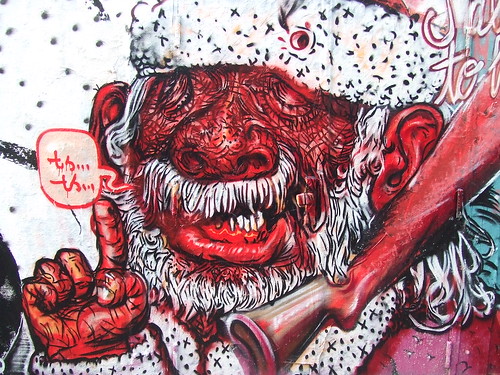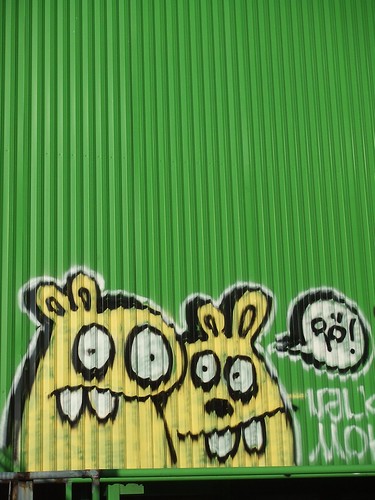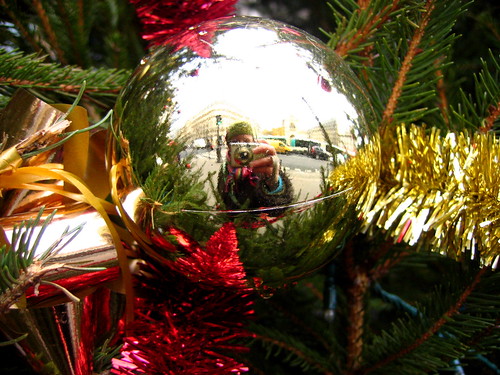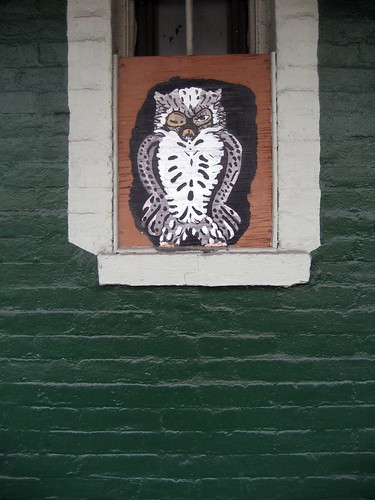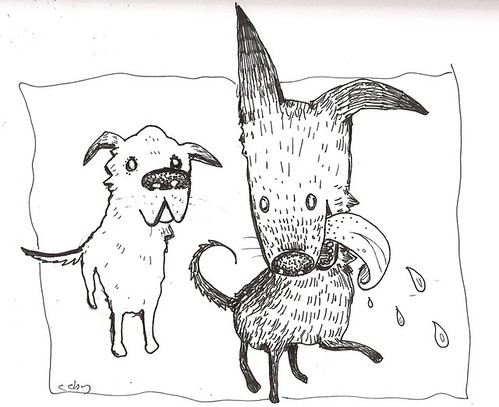"for the rest of us" | edited by Morris Armstrong, Jr. proudly a.k.a. "Little Mo", author of The Concrete Jungle Book
31 December 2008
30 December 2008
29 December 2008
28 December 2008
Où est passée la Mère Noël ?
La Mère Noël - Bérurier Noir
Où est passé le Père Noël ?
Où est passée la Mère Noël ?
Où est passé le Père Noël ?
Pour les gosses défavorisés ?
Où est passée la Mère Noël ?
Ding Dong Ding Dong
27 December 2008
26 December 2008
24 December 2008
quote of the day
All the arguments to prove man's superiority cannot shatter this hard fact: in suffering the animals are our equals.
-Peter Singer, philosopher, professor of bioethics (b. 1946)
23 December 2008
headline of the day: "Honeybees succumb to cocaine's allure"

Honeybees succumb to cocaine's allure
Since its discovery in the 18th century, cocaine has been a scourge of western society. Strongly stimulating human reward centres in low doses, cocaine is extremely addictive and can be fatal in high doses. But this potent compound did not evolve to ensnare humans in addiction. Andrew Barron from Macquarie University, Australia, explains that cocaine is a powerful insect neurotoxin, protecting coca bushes from munching insects without rewarding them. Knowing that foraging honey bees are strongly motivated by rewards (they dance in response to the discovery of a rewarding nectar or pollen supply) and that this behaviour is controlled by similar mechanisms to the ones that leave humans vulnerable to cocaine addiction, Barron and Gene Robinson from the University of Illinois at Urbana-Champaign wondered whether bees may be vulnerable to cocaine's allure at the right dose. Teaming up with Ryszard Maleszka at the Australian National University, Barron set about testing how honeybees respond to cocaine. They publish their results on 26th December 2008 in The Journal of Experimental Biology at http://jeb.biologists.org.
Setting up his hives on a farm just outside Canberra, Barron trained the insects to visit a feeder stocked with a sugar solution. Then he gently applied a tiny drop of cocaine solution to the insect's back, and waited to see how enthusiastically the foraging insects danced when returning to the hive. Amazingly, low doses of the drug stimulated the insects to dance extremely vigorously. They behaved as if the sucrose solution was of a much higher quality than it really was. The cocaine seemed to be hitting the insects' reward centres, but were they really responding to the drug like humans or was the drug stimulating some other aspect of the insects' behaviour to look as if they were becoming addicted?
Working with a team of undergraduate students, Barron tested whether cocaine stimulated the insects' locomotion centres by monitoring their movements after a dose of the drug. The insects behaved normally, so the drug probably doesn't affect their movements. However, when Paul Helliwell tested the bees' sensitivity to sugar solutions, the drugged bees responded more strongly than the undrugged insects, so cocaine was increasing their sugar sensitivity. But was it only increasing their sensitivity to sugar, or increasing their response to all rewards? Barron offered the drugged insects pollen to see if cocaine increased their sensitivity to other floral rewards and found that the foragers were equally overenthusiastic, dancing as if the pollen quality was much better than it really was.
Finally Barron and Helliwell wondered whether bees that had been on cocaine for a few days had become dependent and went into withdrawal when the drug was withheld. Testing the insects' ability to learn to distinguish between lemon and vanilla scents, they found that the bees were fine so long as their cocaine supply was maintained. But as soon as the drug was withdrawn the bees had difficulty learning the task, just like humans going into withdrawal.
Barron is confident that honeybees are as susceptible to cocaine's allure as humans, and is keen to find out more about the drug's effects. He hopes to identify the neural pathways that it targets to find out more about the mechanisms involved in human addiction and to find out whether the drug has as devastating an effect on honey bee society as it does on human society.
###IF REPORTING ON THIS STORY, PLEASE MENTION THE JOURNAL OF EXPERIMENTAL BIOLOGY AS THE SOURCE AND, IF REPORTING ONLINE, PLEASE CARRY A LINK TO: http://jeb.biologists.org
REFERENCE: Barron, A. B., Maleszka, R., Helliwell, P. G. and Robinson, G. E. (2009). Effects of cocaine on honey bee dance behaviour. J. Exp. Biol. 212, 163-168.
THIS ARTICLE APPEARS IN THE JOURNAL OF EXPERIMENTAL BIOLOGY ISSUE: 26th December 2008.
22 December 2008
21 December 2008
20 December 2008
what are the orcas trying to tell us?

Whale Poop Analyzed For Clues To Orca Decline
Using a trained dog to sniff for poop and petri dishes attached to long poles, scientists are analyzing killer whales' scat and breath samples in the hopes of solving the mystery of Puget Sound's dwindling orca population. […]
19 December 2008
Researcher 'sings' for a living to decode bird songs
To many people, bird song can herald the coming of spring, reveal what kind of bird is perched nearby or be merely an unwelcome early morning intrusion. But to Sandra Vehrencamp, Cornell professor of neurobiology and behavior, bird song is a code from which to glean insights into avian behavior.
 Provided |
| Cornell behavioral ecologist Sandra Vehrencamp records bird songs in Santa Rosa National Park, Guanacaste, Costa Rica, and then plays them back to other birds of the same species to try to determine exactly how birds communicate through their vocalizations. |
Birds use song systems to communicate about mating and reproduction, territorial boundaries, age and even overall health. Vehrencamp studies them to decode which elements convey such essential information. With colleagues in the Bioacoustics Research Program at Cornell's Lab of Ornithology, she studies birds in such natural habitats as Costa Rica, Colombia and Bonaire.
Vehrencamp records bird songs and then plays them back to birds of the same species to decipher strategies that various species use to attract mates and resolve territorial disputes. The technique allows researchers to study birds' reactions to songs when such elements as overlapping vocalization, finer song structural features and the type of song played back are varied.
"You kind of feel like you're talking to the bird," Vehrencamp said.
She found, for example, that song sparrows in southern California can interpret some forms of playback as "fighting words," because they often resolve conflict by singing the same type of song -- known as song-type matching -- back to one another.
"They get really mad," Vehrencamp said. "They treat playback like it's another bird and will sometimes come right up to the speaker."
Between male birds, if song-type matching fails to resolve a conflict, physical confrontation might ensue. "They both pay costs if they fight," Vehrencamp said. "Birds start to negotiate a boundary dispute with song -- they don't want to fight."
Vehrencamp's work also suggests that males that are most successful are those that share many song types with their territorial neighbors. Song sparrows, for example, can learn songs only within a narrow time period restricted to the first few months after fledging, which means that males must learn neighborhood songs quickly to facilitate successful territorial negotiations.
 Provided |
| A male banded wren (Thryothorus pleurostictus) that was captured in a mist net and individually marked with colored leg bands for the study on examining the meanings of song birds. |
"Song sparrows are very restricted learners, so the dominant birds that acquire territories within their natal area share more song types with their neighbors and survive better," explained Vehrencamp, who observed that birds with a low degree of song-sharing spend more time fighting with neighbors and are rarely seen the next breeding season.
Vehrencamp also studies the banded wren in Central America. This species has a longer learning period, up to a year or more, so all birds in the neighborhood share a large fraction of their song types. "Males get up early, and sing vigorously with frequent song-type matching in what's called a dawn chorus," Vehrencamp said. "We think they're singing to other males, but the females are listening, too."
Type-matching not only indicates aggressive intentions, but enables the birds to compare each other's singing performance for each type of song. Her study suggests that such detail as the trill elements in a song are used by listeners to indicate the singer's overall fitness. "You really have to be in top-notch shape to produce these elements well," she said, adding that a well-sung song in wrens or a large song repertoire in tropical mockingbirds, another species Vehrencamp studies, can indicate the age of a bird. Older males are generally preferred by females because they have a proven ability to survive.
To study how the wrens pay attention to these finer details, Vehrencamp created a "super male" by manipulating the fine-structure elements in song recordings. Territory owners, she found, were reluctant to approach the speaker and chase off such strong "intruders".
And when she genetically tested offspring to determine paternity, she found that singing was a factor when females sought to breed with males that weren't their mates.
"In general, these wrens are quite faithful, but every once in a while we find evidence of extra-pair mating, and the extra-pair mates always had better song quality," she said. "So we know females pay attention to fine song structure."
Vehrencamp said that placing such avian observations within a larger framework can help predict what effects environmental factors -- including humans -- might have on an animal's behavior or survival.
"If we can understand the ecological factors that enhance reproductive success and can link them to conservation, then we might be able to save a species," she said. She added that by better understanding how ecological factors affect the evolution of social behavior, "you can see where humans fit into the big picture, and that adds a richness and depth of understanding for why we are the sorts of animals that we are."
Graduate student Nadia Drake is a science writer intern at the Cornell Chronicle.
the nature of the beast
John Gray
THE NATURE OF THE BEAST
The Philosopher and the Wolf: Lessons from the Wild on Love, Death and Happiness
By Mark Rowlands (Granta Books 246pp £15.99)
 The idea that when humans are at their worst they behave like wolves has been around a long time. Hobbes used the Latin tag homo homini lupus - man is a wolf to man - to illustrate his belief that unless they are restrained by government, people prey upon one another ruthlessly, while descriptions of rapacious or amoral behaviour as wolfish can be found throughout literature. The notion that evil is the expression of bestial instincts is deeply ingrained, and for the average philosopher as for the average person there is nothing more bestial than the wolf. More generally, a belief in the innate superiority of humans over other animals is part of the Western tradition. Christians tell us that only humans have souls, and though they speak in a different language secular thinkers mostly believe much the same. There are innumerable secular rationalists who, while congratulating themselves on their scepticism, never doubt that the universe is improved by the presence in it of humans like themselves.
The idea that when humans are at their worst they behave like wolves has been around a long time. Hobbes used the Latin tag homo homini lupus - man is a wolf to man - to illustrate his belief that unless they are restrained by government, people prey upon one another ruthlessly, while descriptions of rapacious or amoral behaviour as wolfish can be found throughout literature. The notion that evil is the expression of bestial instincts is deeply ingrained, and for the average philosopher as for the average person there is nothing more bestial than the wolf. More generally, a belief in the innate superiority of humans over other animals is part of the Western tradition. Christians tell us that only humans have souls, and though they speak in a different language secular thinkers mostly believe much the same. There are innumerable secular rationalists who, while congratulating themselves on their scepticism, never doubt that the universe is improved by the presence in it of humans like themselves.
The Philosopher and the Wolf is a powerfully subversive critique of the unexamined assumptions that shape the way most philosophers - along with most people - think about animals and themselves. When Rowlands bought a wolf cub for $500, and lived with it for eleven years, he ended up writing: 'Much of what I learned, about how to live and how to conduct myself, I learned during those eleven years. Much of what I know about life and its meaning I learned from him. What it is to be human: I learned this from a wolf.' A part of Rowlands's life with Brenin was sheer delight: 'The wolf is art of the highest form and you cannot be in its presence without this lifting your spirits.' Beyond its beauty, though, the wolf taught the philosopher something about the meaning of happiness. Humans tend to think of their lives as progressing towards some kind of eventual fulfilment; when this is not forthcoming they seek satisfaction or distraction in anything that is new or different. This human search for happiness is 'regressive and futile', for each valuable moment slips away in the pursuit of others and they are all swallowed up by death. In contrast, living without the sense of time as a line pointing to an end-point, wolves find happiness in the repetition of fulfilling moments, each complete and self-contained. As a result, as Rowlands shows in a moving account of his last year with Brenin, they can flourish in the face of painful illness and encroaching death.
The wolf accompanied Rowlands to lectures, restaurants and sports complexes, joined him on his walks, runs and road trips, woke him up in the morning (sometimes by presenting him with a dead bird) and lay under his desk while he worked. After an initial period in which Rowlands applied a softer version of the methods of a famous animal trainer, William Koehler, the wolf was rarely on a leash. Having learnt to follow Rowlands's lead, and knowing what it could and could not do, Brenin needed no restraint.
There will be some who will say Rowlands imposed an unnatural existence on the wolf, and in one sense this is obviously true. Brenin lived in an environment quite different from that in which wolves evolved and spent most of their history as a species. It does not follow that the wolf's life was denatured or impoverished. In one of the arresting passages of lucid reflection that punctuate the book's narrative, Rowlands attacks the idea that animals are 'biological marionettes', programmed to live out a single biological destiny. The fox that showed up looking for food in the garden of a Gatwick hotel, where Rowlands was having a beer before catching a flight, was engaged in a pursuit that came naturally to it. Equally, Brenin's life was different from that which any wolf could have lived in the wild, but that life was no less natural, or - on the account that Rowlands gives of it - any less happy. Like humans, animals can thrive in many different ways.
The bond that Rowlands formed with Brenin was based on the fact that the wolf had emotions in common with the philosopher, such as courage, affection and delight in play. At the same time, Rowlands seems clearly to have been drawn to the wolf because of its profound differences from humans. In evolutionary terms humans belong in the ape family, and if apes are intellectually superior to other animals it is because of their highly developed social intelligence. Some of the most valuable features of human life - science and the arts, for example - are only possible because of this intelligence. But it is also this type of intelligence that enables apes - some kinds of ape, at any rate - to engage in forms of behaviour that, when more fully developed, embody types of malignancy that are pre-eminently human. As Rowlands puts it: 'When we talk about the superior intelligence of apes, we should bear in mind the terms of this comparison: apes are more intelligent than wolves because, ultimately, they are better schemers and deceivers than wolves.' The ability to scheme and deceive requires a capacity to enter the minds of others, which other animals seem not to possess in anything like the same degree. But the human capacity for empathy brings something new into the world - a kind of malice aforethought, a delight in the pain of others that aims to reduce them to the condition of powerless victims. If the philosopher loved the wolf, it was because while it could kill without emotion it lacked this distinctively human trait.
Among other things The Philosopher and the Wolf is a series of unsentimental reflections on human evil. Rowlands does not think of evil in simple terms, as mere Schadenfreude - it is far more complicated than that. But neither does he share the rationalist delusion that evil is a kind of error, which can be removed from human life by better knowledge and improved understanding. On the contrary, unfashionably but to my mind rightly, Rowlands accepts that evil is part of human nature, which can be moderated but never eradicated.
Mark Rowlands tells us he has long pondered the claim, often advanced as an objection to his life with Brenin, that wolves have no place in civilised society, and has finally concluded that it's true. The reason is not that Brenin was too dangerous to be allowed in civilised company. Rather, it is that 'he was nowhere near dangerous, and nowhere near unpleasant, enough. Civilisation, I think, is possible only for deeply unpleasant animals.' I would put the point rather differently. Civilisation is a way of coping with what that supremely great twentieth-century poet Wallace Stevens called 'the unalterable necessity of being this unalterable animal'. The dark side of the human animal is not wolf-like; it is ape-like, and at its worst peculiarly human. In other words, civilisation is a defence erected by humanity not against bestiality, but against itself.
John Gray's most recent book is 'Black Mass: Apocalyptic Religion and the Death of Utopia' (Penguin).
17 December 2008
detail: postmark, elephant

detail: postmark, elephant by http://TheConcreteJungleBook.com , originally uploaded by http://TheConcreteJungleBook.com.
detail of mixed media collage by Morris Armstrong, Jr., proudly a.k.a. "Little Mo"
for RJPN (en route to ontario)
"cascading confession collage canvas. fragment pages and photos on 15x30 inch canvas"
16 December 2008
dieselpunk

http://www.darkroastedblend.com/2008/12/dieselpunk.html
"True to the name, this movement sings jazzy paens to convoluted and impressive tangles of pipes, chambers, pistons, and has the mighty Torque in the center of it all."
what's a whinny to a horse?
Horses have an almost human ability to conjure up visual memories of their herd-mates from the sound of their whinnies, a study has shown.
Research by scientists at the University of Sussex revealed the animals were surprised when they heard the "wrong" whinny from a herd member.
This "cross modal" recognition was once thought to be a purely human trait.
Twelve horses from Woodingdean livery yard, Brighton, and 12 from Sussex Horse Rescue, Uckfield, were studied.
Horses make a whinnying sound when they become separated from their group.
'Expectations violated'
During the team's research, one of two familiar members of the herd was led past the horses and then behind a visual barrier.
Once the animal was out of sight the horses were played a recording of a whinny that either matched the herd-mate they had just seen or the other animal.
The scientists found that when the whinny sound did not match the herd-member seen walking behind the barrier the horses seemed startled.
The findings, made by Dr Karen McComb and her team from University of Sussex in Brighton, were published in the journal Proceedings of the National Academy of Sciences.
The team wrote in the journal: "Overall, horses responded quicker and looked for a longer time during trials in which the familiar call heard did not match the familiar horse previously seen, indicating that the incongruent combination violated their expectations.
"This is the first clear empirical demonstration that in the normal process of identifying social companions of its own species, a non-human animal is capable of cross-modal individual recognition."
Story from BBC NEWS:
http://news.bbc.co.uk/go/pr/fr/-/2/hi/uk_news/england/sussex/7784790.stm
Published: 2008/12/15 23:07:28 GMT
© BBC MMVIII





